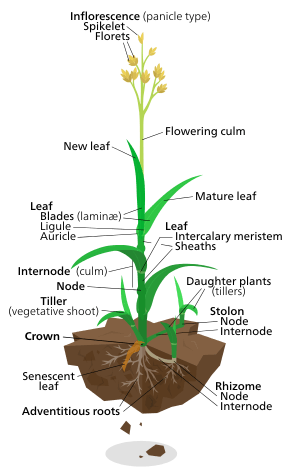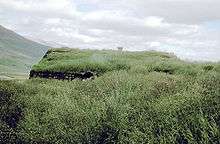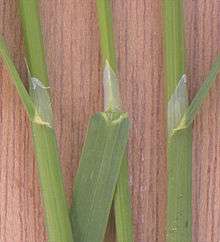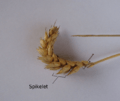Poaceae
| Poaceae (true grasses) Temporal range: Late Cretaceous[1] - recent, 66–0 Ma | |
|---|---|
 | |
| Flowering head of meadow foxtail (Alopecurus pratensis), with stamens exerted at anthesis | |
| Scientific classification | |
| Kingdom: | Plantae |
| (unranked): | Angiosperms |
| (unranked): | Monocots |
| (unranked): | Commelinids |
| Order: | Poales |
| Family: | Poaceae Barnhart[2] |
| Type genus | |
| Poa L. | |
| Subfamilies | |
The Poaceae (English pronunciation: /poʊˈeɪ.siˌiː/) (also called Gramineae or grasses) are a large and nearly ubiquitous family of monocotyledonous flowering plants. With more than 10,000 species, the Poaceae are the fourth-largest plant family, following the Asteraceae, Orchidaceae and Fabaceae.[3] Though commonly called "grasses", seagrasses, rushes, and sedges fall outside this family. The rushes and sedges are related to the Poaceae, being members of the order Poales, but the seagrasses are members of order Alismatales.
Grasslands are estimated to constitute 20% of the vegetation cover of the Earth. Poaceae live in many other habitats, including wetlands, forests, and tundra.
The Poaceae are the most economically important plant family, providing staple foods from domesticated cereal crops such as maize (corn), wheat, rice, barley, and millet as well as forage, building materials (bamboo, thatch, straw) and fuel (ethanol).
Description

Grasses generally have the following characteristics (the image gallery can be used for reference):
Poaceae have hollow stems called culms plugged at intervals by solid leaf-bearing nodes. Grass leaves are nearly always alternate and distichous (in one plane), and have parallel veins. Each leaf is differentiated into a lower sheath hugging the stem and a blade with entire (i.e., smooth) margins. The leaf blades of many grasses are hardened with silica phytoliths, which discourage grazing animals; some, such as sword grass, are sharp enough to cut human skin. A membranous appendage or fringe of hairs called the ligule lies at the junction between sheath and blade, preventing water or insects from penetrating into the sheath.

Flowers of Poaceae are characteristically arranged in spikelets, each having one or more florets. The spikelets are further grouped into panicles or spikes. The part of the spikelet that bears the florets is called the rachilla. A spikelet consists of two (or sometimes fewer) bracts at the base, called glumes, followed by one or more florets. A floret consists of the flower surrounded by two bracts, one external—the lemma—and one internal—the palea. The flowers are usually hermaphroditic—maize being an important exception—and anemophilous or wind-pollinated. The perianth is reduced to two scales, called lodicules, that expand and contract to spread the lemma and palea; these are generally interpreted to be modified sepals. This complex structure can be seen in the image on the right, portraying a wheat (Triticum aestivum) spikelet.
The fruit of Poaceae is a caryopsis, in which the seed coat is fused to the fruit wall.
A tiller is a leafy shoot other than the first shoot produced from the seed.
Growth and development

Grass blades grow at the base of the blade and not from elongated stem tips. This low growth point evolved in response to grazing animals and allows grasses to be grazed or mown regularly without severe damage to the plant.[4]
Three general classifications of growth habit present in grasses: bunch-type (also called caespitose), stoloniferous, and rhizomatous.
The success of the grasses lies in part in their morphology and growth processes and in part in their physiological diversity. Most of the grasses divide into two physiological groups, using the C3 and C4 photosynthetic pathways for carbon fixation. The C4 grasses have a photosynthetic pathway, linked to specialized Kranz leaf anatomy, which allows for increased water use efficiency, rendering them better adapted to hot, arid environments and those lacking in carbon dioxide.
The C3 grasses are referred to as "cool-season" grasses, while the C4 plants are considered "warm-season" grasses; they may be either annual or perennial.
- Annual cool-season - wheat, rye, annual bluegrass (annual meadowgrass, Poa annua), and oat
- Perennial cool-season - orchardgrass (cocksfoot, Dactylis glomerata), fescue (Festuca spp.), Kentucky bluegrass and perennial ryegrass (Lolium perenne)
- Annual warm-season - maize, sudangrass, and pearl millet
- Perennial warm-season - big bluestem, Indiangrass, Bermudagrass and switchgrass.
Ecology
Grass-dominated biomes are called grasslands. If only large, contiguous areas of grasslands are counted, these biomes cover 31% of the planet's land.[5] Grasslands include pampas, steppes, and prairies.
Grasses provide food to many grazing mammals—such as livestock, deer, and elephants—as well as to many species of butterflies and moths.
The evolution of large grazing animals in the Cenozoic contributed to the spread of grasses. Without large grazers, fire-cleared areas are quickly colonized by grasses, and with enough rain, tree seedlings. Trees eventually shade out and kill most grasses. Trampling grazers kill seedling trees but not grasses.[6]
Evolution
Cladogram showing subfamilies and in brackets approximate species numbers:[7]
| |
| ||||||||||||||||||||||||||||||||||||||||||||||||||||||||||||||||||
| |
Until recently, fossil findings indicated that grasses evolved around 55 million years ago. Recent findings of grass-like phytoliths in Cretaceous dinosaur coprolites have pushed this date back to 66 million years ago.[1][8] Indeed, revised dating of the origins of the rice tribe Oryzeae suggest a date as early as 107 to 129 Mya.[9]
The relationships among the subfamilies Bambusoideae, Oryzoideae and Pooideae in the BOP clade have been resolved: Bambusoideae and Pooideae are more closely related to each other than to Oryzoideae.[10] This separation occurred within a relatively short time span (about 4 million years).
Distribution
The grass family is one of the most widely distributed and abundant groups of plants on Earth. Grasses are found on every continent,[11] and are absent only from central Greenland and much of Antarctica.[12]
Taxonomy

Recent classifications of the grass family[13] recognize 12 subfamilies and a small number of taxa with uncertain placements:
- Anomochlooideae Potztal, a small lineage of broad-leaved grasses that includes two genera (Anomochloa, Streptochaeta)
- Pharoideae L.G.Clark & Judz., a small lineage of grasses of three genera, including Pharus and Leptaspis
- Puelioideae L.G.Clark, M.Kobay., S.Mathews, Spangler & E.A.Kellogg, a small lineage of the African genus Puelia
- Pooideae, including wheat, barley, oats, brome-grass (Bromus), reed-grasses (Calamagrostis) and many lawn and pasture grasses
- Bambusoideae, including bamboo
- Ehrhartoideae, including rice and wild rice
- Aristidoideae, including Aristida
- Arundinoideae, including giant reed and common reed
- Chloridoideae, including the lovegrasses (Eragrostis, about 350 species, including teff), dropseeds (Sporobolus, some 160 species), finger millet (Eleusine coracana (L.) Gaertn.), and the muhly grasses (Muhlenbergia, about 175 species)
- Panicoideae, including panic grass, maize, sorghum, sugarcane, most millets, fonio, and bluestem grasses
- Micrairoideae
- Danthonioideae, including pampas grass
Depending on the classification followed, the family includes around 668 genera.[3]
Etymology
The name Poaceae was given by John Hendley Barnhart in 1895,[14] based on the tribe Poeae (described in 1814 by Robert Brown), and the type genus Poa (described in 1753 by Carl Linnaeus). The term is derived from the Ancient Greek term for grass.
Uses
Grasses are, in human terms, perhaps the most economically important plant family. Grasses' economic importance stems from several areas, including food production, industry, and lawns.
Food production
Agricultural grasses grown for their edible seeds are called cereals or grains (although the latter term, agriculturally, refers to both cereals and legumes). Three cereals – rice, wheat, and maize (corn) – provide more than half of all calories eaten by humans.[15] Of all crops, 70% are grasses.[16] Cereals constitute the major source of carbohydrates for humans and perhaps the major source of protein, and include rice in southern and eastern Asia, maize in Central and South America, and wheat and barley in Europe, northern Asia and the Americas.
Sugarcane is the major source of sugar production. Many other grasses are grown for forage and fodder for animal feed, particularly for sheep and cattle, thereby indirectly providing more human calories.
Industry
Grasses are used for construction. Scaffolding made from bamboo is able to withstand typhoon-force winds that would break steel scaffolding.[5] Larger bamboos and Arundo donax have stout culms that can be used in a manner similar to timber, and grass roots stabilize the sod of sod houses. Arundo is used to make reeds for woodwind instruments, and bamboo is used for innumerable implements.
Grass fiber can be used for making paper, and for biofuel production.
Phragmites australis (common reed) is important in water treatment, wetland habitat preservation and land reclamation in Afro-Eurasia.
Lawn and ornamental grasses
Grasses are the primary plant used in lawns, which themselves derive from grazed grasslands in Europe. They also provide an important means of erosion control (e.g., along roadsides), especially on sloping land.
Although supplanted by artificial turf in some games, grasses are still an important covering of playing surfaces in many sports, including football (soccer), tennis, golf, cricket, softball and baseball.
Ornamental grasses, such as perennial bunch grasses, are used in many styles of garden design for their foliage, inflorescences, seed heads, and slope stabilization. They are often used in natural landscaping, xeriscaping, contemporary or modern landscaping, wildlife gardening, and native plant gardening.
Economically important grasses
|
|
|
|
Grasses and society

Grasses have long had significance in human society. They have been cultivated as feed for domesticated animals for up to 10,000 years, and have been used to make paper since the second century AD. Also, the primary ingredient of beer is usually barley or wheat, both of which have been used for this purpose for over 4,000 years.
Some common aphorisms involve grass. For example:
- "The grass is always greener on the other side" suggests an alternate state of affairs will always seem preferable to one's own.
- "Don't let the grass grow under your feet" tells someone to get moving.
- "A snake in the grass" means dangers that are hidden.
- "When elephants fight, it is the grass which suffers" tells of bystanders caught in the crossfire.
A folk myth about grass is that it refuses to grow where any violent death has occurred.[17]
Genera
See the full list of Poaceae genera.
Image gallery
-

Leaves of Poa trivialis showing the ligules
-

Bamboo stem and leaves, nodes are evident
-

A Chasmanthium latifolium spikelet
-

Wheat spike and spikelet
-

Spikelet opened to show caryopsis
-

Harestail grass
-

Grass
-
Sugarcane (Saccharum officinarum)
-

Roots of Bromus hordeaceus
-

Barley mature spikes (Hordeum vulgare)
-

Illustration depicting both staminate and pistillate flowers of maize (Zea mays)
-
A grass flower head (meadow foxtail) showing the plain-coloured flowers with large anthers.
-
Anthers detached from a meadow foxtail flower
-

Setaria verticillata, bristly foxtail
-

Setaria verticillata, bristly foxtail
See also
References
- 1 2 Piperno, Dolores R.; Sues, Hans-Dieter (2005). "Dinosaurs Dined on Grass". Science 310 (5751): 1126–8. doi:10.1126/science.1121020. PMID 16293745.
- ↑ Angiosperm Phylogeny Group (2009). "An update of the Angiosperm Phylogeny Group classification for the orders and families of flowering plants: APG III" (PDF). Botanical Journal of the Linnean Society 161 (2): 105–121. doi:10.1111/j.1095-8339.2009.00996.x. Retrieved 2013-06-26.
- 1 2 Stevens, P.F. "Angiosperm Phylogeny Website". Retrieved 2007-10-07.
- ↑ David Attenborough (1984). The Living Planet. British Broadcasting Corporation. pp. 113–4. ISBN 0-563-20207-6.
- 1 2 George Constable (ed), ed. (1985). Grasslands and Tundra. Planet Earth. Time Life Books. p. 20. ISBN 0-8094-4520-4.
- ↑ David Attenborough (1984). The Living Planet. British Broadcasting Corporation. p. 137.
- ↑ Grass Phylogeny Working Group II (2012). "New grass phylogeny resolves deep evolutionary relationships and discovers C4 origins". New Phytologist 193 (2): 304–312. doi:10.1111/j.1469-8137.2011.03972.x. PMID 22115274.

- ↑ Prasad, V.; Stroemberg, C.A.E.; Alimohammadian, H.; Sahni, A. (2005). "Dinosaur Coprolites and the Early Evolution of Grasses and Grazers". Science 310 (5751): 1177–1180. doi:10.1126/science.1118806. PMID 16293759.
- ↑ Prasad V, Strömberg CA, Leaché AD, Samant B, Patnaik R, Tang L, Mohabey DM, Ge S, Sahni A. (2011). Late Cretaceous origin of the rice tribe provides evidence for early diversification in Poaceae. Nat Commun. 2:480. doi:10.1038/ncomms1482 PMID 21934664
- ↑ Wu ZQ, Ge S (2011) The phylogeny of the BEP clade in grasses revisited: Evidence from the whole-genome sequences of chloroplasts. Mol Phylogenet Evol
- ↑ Sarandón, Ramiro (1988). "Biología poblacional del gramon (Cynodon spp., gramineae)": 189. Retrieved 22 April 2014.
- ↑ "Angiosperm phylogeny website". Retrieved 2007-10-07.
- ↑ "Catalogue of New World Grasses". Retrieved 2012-03-01.
- ↑ Barnhart, J.H. (1895). "Poaceae". Bulletin of the Torrey Botanical Club 22: 7.
- ↑ Peter H. Raven & George B. Johnson (1995). Carol J. Mills (ed), ed. Understanding Biology (3rd ed.). WM C. Brown. p. 536. ISBN 0-697-22213-6.
- ↑ George Constable (ed), ed. (1985). Grasslands and Tundra. Planet Earth. Time Life Books. p. 19. ISBN 0-8094-4520-4.
- ↑ Olmert, Michael (1996). Milton's Teeth and Ovid's Umbrella: Curiouser & Curiouser Adventures in History, p. 208. Simon & Schuster, New York. ISBN 0-684-80164-7.
External links
| Wikimedia Commons has media related to Poaceae. |
| Wikispecies has information related to: Poaceae |
- Poaceae at The Plant List
- Gramineae at The Families of Flowering Plants (DELTA)
- Poaceae at the Encyclopedia of Life
- Poaceae at the Angiosperm Phylogeny Website
- Poaceae Classification from the online Catalogue of New World Grasses
- Poaceae at the online Flora of China
- Poaceae at the online Guide to the Flora of Mongolia
- Poaceae at the online Flora of Taiwan
- Poaceae at the online Flora of Pakistan
- Poaceae at the online Flora of Zimbabwe
- Poaceae at the online Flora of Western Australia
- Grasses of Australia (AusGrass2) - http://ausgrass2.myspecies.info/
- Gramineae at the online Flora of New Zealand
- NZ Grass Key An Interactive Key to New Zealand Grasses at Landcare Research
- The Grass Genera of the World at DELTA intkey
- GrassBase - The Online World Grass Flora at the Royal Botanic Gardens - Kew
- GrassWorld - http://grassworld.myspecies.info/
| ||||||||||||||||||||||||||||||||||||||||||||||||||||
| ||||||||||||||||||||||||||||||||||||||||||||||||||||||||||||||||
|

